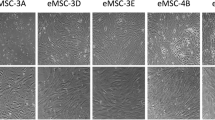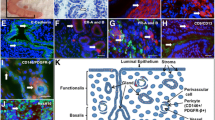Abstract
Endometrial epithelial cells (EECs) cultured in vitro are valuable tools for investigating embryo implantation and trophoblast differentiation. In this study, we have established the bovine EECs and trophoblast stem-like (TS) coculture system, and used it to investigate the binucleate cell formation of ungulates. The EECs was derived from the uterine horn ipsilateral to the corpus luteum by using collagenase I and deoxyribonuclease I, which exhibited typical epithelial morphology and were expressing bovine uterine epithelial marker such as IFNAR1, IFNAR2, Erα, PGR, ESR1 and KRT18. The cells immunostained positively by epithelial and trophectoderm marker cytokeratin 18 (KRT18) and stromal marker vimentin antibodies, and the KRT18 positive cells reached 99 %. The EECs can be cultured for up to 20 passages in vitro with no significant morphology changes and uterine epithelial marker gene expression alteration. The bTS cells were established in a dual inhibitor system and exhibited typical trophoblast stem cell characteristics. When bTS cells were cultured with EECs, the bTS cells adhered to the EECs as adhering to feeder cells. Binucleate cells began appearing on day 4 of coculture and reached approximately 18.47 % of the differentiated cells. Quantitative real-time PCR or immunofluorescence analyses were performed on bTS cells cocultured at day 6 and day 12. The results showed that the expression level of KRT18 was down-regulated while the expression level of trophoblast differentiation marker MASH2, HAND1, GCM1 and CDX2 was up-regulated in bTS cells. In conclusion, bovine EECs can be obtained from the uterine horn ipsilateral to the corpus luteum via treatment with collagenase I and deoxyribonuclease I, and the EECs-bTS cells coculture system presents an ideal tool for studying the differentiation of bTS cells to trophoblast binucleate cells.




Similar content being viewed by others
References
Bai H, Sakurai T, Bai R, Yamakoshi S, Aoki E, Kuse M, Okuda K, Imakawa K (2014) Establishment and characterization of immortalized bovine endometrial epithelial cells. Anim Sci J 85:799–804. doi:10.1111/asj.12202
Bergh J, Nilsson K, Dahl D, Andersson L, Virtanen I, Lehto VP (1984) Expression of intermediate filaments in established human lung cancer cell lines. An indicator of differentiation and derivation. Lab Investig J Tech Methods Pathol 51:307–316
Denker HW (1993) Implantation: a cell biological paradox. J Exp Zool 266:541–558. doi:10.1002/jez.1402660606
Fortier MA, Guilbault LA, Grasso F (1988) Specific properties of epithelial and stromal cells from the endometrium of cows. J Reprod Fertil 83:239–248
Hashizume K, Ushizawa K, Patel OV, Kizaki K, Imai K, Yamada O, Nakano H, Takahashi T (2007) Gene expression and maintenance of pregnancy in bovine: roles of trophoblastic binucleate cell-specific molecules. Reprod Fertil Dev 19:79–90. doi:10.1071/Rd06118
Horn S, Bathgate R, Lioutas C, Bracken K, Ivell R (1998) Bovine endometrial epithelial cells as a model system to study oxytocin receptor regulation. Hum Reprod Update 4:605–614
Hou D, Su M, Li X, Li Z, Yun T, Zhao Y, Zhang M, Zhao L, Li R, Yu H, Li X (2015) The efficient derivation of trophoblast cells from porcine in vitro fertilized and parthenogenetic blastocysts and culture with ROCK inhibitor Y-27632. PLoS ONE 10:e0142442. doi:10.1371/journal.pone.0142442
Huang X, Han X, Uyunbilig B, Zhang M, Duo S, Zuo Y, Zhao Y, Yun T, Tai D, Wang C, Li J, Li X, Li R (2014) Establishment of bovine trophoblast stem-like cells from in vitro-produced blastocyst-stage embryos using two inhibitors. Stem Cells Dev 23:1501–1514. doi:10.1089/scd.2013.0329
Krishnaswamy N, Danyod G, Chapdelaine P, Fortier MA (2009) Oxytocin receptor down-regulation is not necessary for reducing oxytocin-induced prostaglandin F(2alpha) accumulation by interferon-tau in a bovine endometrial epithelial cell line. Endocrinology 150:897–905. doi:10.1210/en.2008-0704
Li P, Tong C, Mehrian-Shai R, Jia L, Wu N, Yan Y, Maxson RE, Schulze EN, Song H, Hsieh CL, Pera MF, Ying QL (2008) Germline competent embryonic stem cells derived from rat blastocysts. Cell 135:1299–1310. doi:10.1016/j.cell.2008.12.006
Munson L, Ellington JE, Schlafer DH (1991) Bovine trophoblastic cell vesicle attachment to polarized endometrial epithelial cells in vitro. In Vitro Cell Dev Biol 27:31–38
Pagan R, Martin I, Alonso A, Llobera M, Vilaro S (1996) Vimentin filaments follow the preexisting cytokeratin network during epithelial-mesenchymal transition of cultured neonatal rat hepatocytes. Exp Cell Res 222:333–344
Sakurai T, Bai H, Bai R, Arai M, Iwazawa M, Zhang J, Konno T, Godkin JD, Okuda K, Imakawa K (2012) Coculture system that mimics in vivo attachment processes in bovine trophoblast cells. Biol Reprod 87:60. doi:10.1095/biolreprod.112.100180
Skarzynski DJ, Miyamoto Y, Okuda K (2000) Production of prostaglandin F2α by cultured bovine endometrial cells in response to tumor necrosis factor α: cell type specificity and intracellular mechanisms. Biol Reprod 62:1116–1120
Thie M, Denker HW (2002) In vitro studies on endometrial adhesiveness for trophoblast: cellular dynamics in uterine epithelial cells. Cells Tissues Organs 172:237–252
Wang G, Johnson GA, Spencer TE, Bazer FW (2000) Isolation, immortalization, and initial characterization of uterine cell lines: an in vitro model system for the porcine uterus. In Vitro Cell Dev Biol Anim 36:650–656
Wooding FB, Flint AP (1994) Placentation. In: Lamming GE (ed) Marshall’s physiology of reproduction: volume 3 pregnancy and lactation. Springer, Dordrecht, pp 233–460. doi:10.1007/978-94-011-1286-4_4
Wooding FB, Morgan G, Monaghan S, Hamon M, Heap RB (1996) Functional specialization in the ruminant placenta: evidence for two populations of fetal binucleate cells of different selective synthetic capacity. Placenta 17:75–86
Yamakoshi S, Bai R, Chaen T, Ideta A, Aoyagi Y, Sakurai T, Konno T, Imakawa K (2012) Expression of mesenchymal-related genes by the bovine trophectoderm following conceptus attachment to the endometrial epithelium. Reproduction 143:377–387. doi:10.1530/REP-11-0364
Zeiler M, Leiser R, Johnson GA, Tinneberg HR, Pfarrer C (2007) Development of an in vitro model for bovine placentation: a comparison of the in vivo and in vitro expression of integrins and components of extracellular matrix in bovine placental cells. Cells Tissues Organs 186:229–242. doi:10.1159/000107947
Zhang S, Lin H, Kong S, Wang S, Wang H, Wang H, Armant DR (2013) Physiological and molecular determinants of embryo implantation. Mol Asp Med 34:939–980. doi:10.1016/j.mam.2012.12.011
Acknowledgments
This work was supported by National Transgenic Project of China (2014ZX08010-001) and National Natural Sciences Foundation of China (31460309).
Author information
Authors and Affiliations
Corresponding author
Rights and permissions
About this article
Cite this article
Li, X., Li, Z., Hou, D. et al. The bovine endometrial epithelial cells promote the differentiation of trophoblast stem-like cells to binucleate trophoblast cells. Cytotechnology 68, 2687–2698 (2016). https://doi.org/10.1007/s10616-016-9994-x
Received:
Accepted:
Published:
Issue Date:
DOI: https://doi.org/10.1007/s10616-016-9994-x




